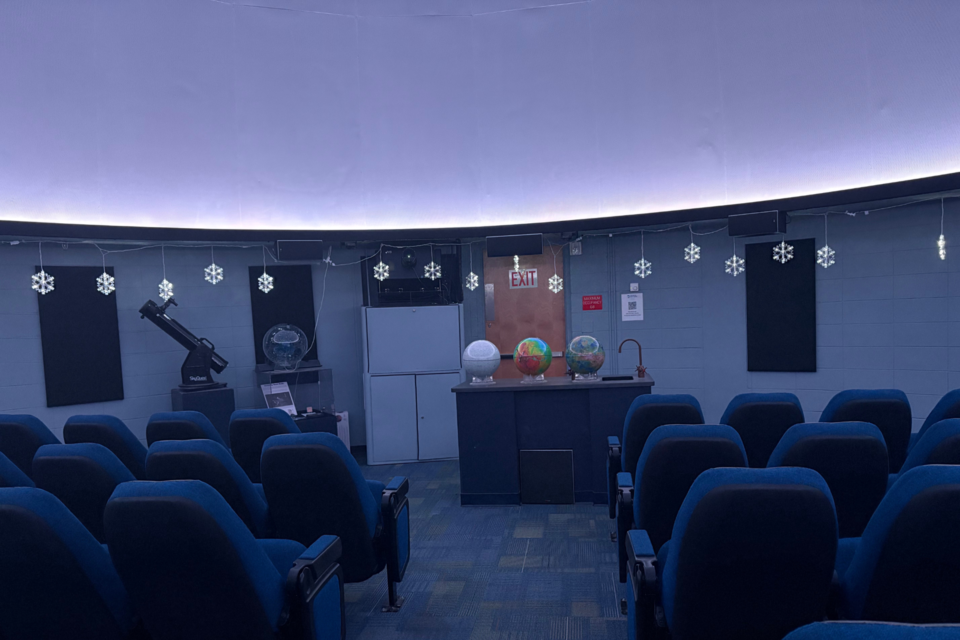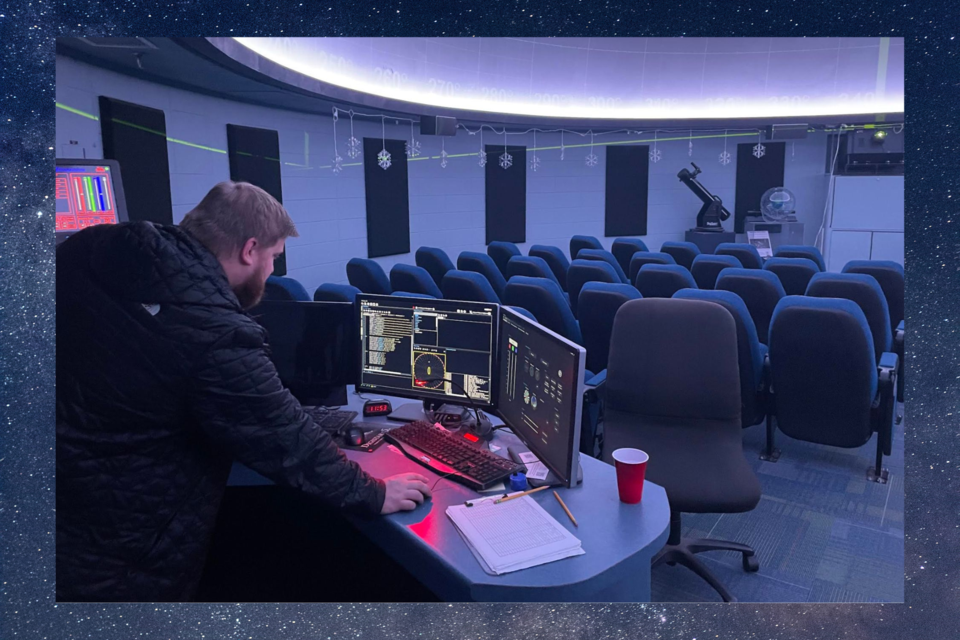Atlantis is not really a place, it's a PEOPLE (MINOAN-CRETAN)
Minoan/Cretan is Atlantis - why don't they tell us the simple truth? When you see the word ROMAN, use Minoan/Cretan instead - it's them... Atlantis is not a place, actually, it's a Ancient CABAL, an EMPIRE, Slave owners, of course.
Exploring the stars and their myths with 'Lamps of Atlantis'

The Georgia Southern University Planetarium recently presented "Lamps of Atlantis," a stellar journey through mythology, science, and ancient civilizations. This immersive show delved into the enduring mystery of the lost continent of Atlantis while exploring ancient astronomy and its connections to history and culture.
"We chose this show because we hadn't played it in a couple of years," explained Dillon Marcy, Planetarium & Astronomy Laboratory Coordinator. "Atlantis is always a big talking point, from conspiracy theories to historical debates. It's fascinating to revisit a story that combines such rich mythology with science."
The show took audiences through the theories surrounding Atlantis, emphasizing its plausible connection to the Minoan civilization, which thrived in the Mediterranean until a volcanic eruption devastated its homeland.

At its core, "Lamps of Atlantis" was an intersection of science, mythology, and storytelling. The production used ancient astronomical tools—like star globes and charts—to interpret how ancient civilizations such as the Egyptians, Minoans, and Greeks viewed the heavens.
"The ancients used astronomy not only for navigation but also as a means of storytelling and scientific exploration," Marcy shared. "This show highlighted how advanced these civilizations were, even without modern technology."
Interestingly, ancient star maps have helped modern scientists uncover celestial events like supernovas. The meticulous star charts of these ancient societies offer insights into how they saw and understood the universe, and they often reveal details that remain astonishing today.
Central to the show's narrative was the legend of Atlantis, first described by the Greek philosopher Plato. While Plato's tale may have been a rhetorical device highlighting Athens' virtues, the myth has persisted as one of history's great mysteries.
"The Atlantis story may have originated to make Athens look good, but the timing aligns almost perfectly with the volcanic eruption that wiped out the Minoan civilization," Marcy noted. "Atlantis was likely not the grand, utopian city many imagine, but rather a small, advanced civilization whose tragic end became legendary."
A highlight of the production was its exploration of how different cultures interpreted the night sky. "In Western traditions, much of our understanding comes from Greek interpretations," said Marcy. "But other cultures, like the Aboriginal Australians, focused on the clouds and the Milky Way, seeing a giant emu, while the Chinese used astronomy for agricultural planning. These diverse perspectives enrich our understanding of humanity's relationship with the stars."
(NOTE: NOT WIPED OUT, Minoans/Cretans/Romans moved around - all the time! SPAIN is on the list) ALSO remember, the Minoans were ANCIENT SEA PEOPLE who changed their identity and moved around the planet. they owned slaves who did all the work, art, etc.)
👇
FAILAKA ISLAND, KUWAIT—According to the Greek Reporter, a joint Kuwaiti-Italian archaeological team unearthed a large ancient Greek building and courtyard at the Al-Qurainiya site on Failaka Island. Failaka is located twelve miles off the coast of Kuwait and was once part of the Seleucid Empire, a Greek-ruled state that emerged after the death of Alexander the Great in 323 b.c. The researchers uncovered traces of stone foundations, plastered walls, pottery fragments, and coins that were all more than 2,000 years old. It is believed that the site, which overlooks the sea in the northern part of the island, was part of a larger settlement that included administrative buildings, houses, and temples that served as a watch point or port during a time when the island was an important hub along trade routes connecting Persia, Mesopotamia, and the broader Hellenistic world. There is speculation that the name Failaka may even derive from the ancient Greek word fylakio, meaning “outpost” or “guardhouse.” For more on Failaka, go to "Archaeology Island."
Excavations reveal “Mosaic House” in ancient Pergamon
Excavations conducted under Turkey’s “Heritage for the Future” project have uncovered a large Roman-era residential complex known as the “Mosaic House” in ancient Pergamon.
Pergamon was an ancient Greek city situated on the northern edge of the Caicus Plain, near modern-day Bergama, Turkey.
During the Hellenistic period, the city emerged as the capital of the Kingdom of Pergamon, a successor state following the collapse of the Lysimachian Empire. Pergamon reached its apex in 188 BC and covered an area of 220 acres.
The city’s builders aspired to create a “second Athens,” featuring a grand acropolis, the renowned Library of Pergamon (considered by ancient sources to be second only to the Library of Alexandria), as well as numerous temples and an impressive theatre capable of seating up to 10,000 spectators. (NOTE: Destroying evidence is why they destroy libraries - to hide their murder/theft/slaveing/looting the planet)
Recent excavations directed by Prof. Dr. Yusuf Sezgin, head of Manisa Celal Bayar University’s Archaeology Department, have uncovered a large residential complex with a peristyele courtyard and pool.
“One of the most remarkable aspects of the Mosaic House is its ornate mosaic flooring, indicating that this was a prestigious residence. We estimate it was built between the 2nd and 3rd centuries AD and may have been abandoned following a devastating fire during the Arab raids of the 7th century,” said Prof. Sezgin. (MINOANS LOVED MOSAIC)
The complex, named the “Mosaic House” by archaeologists, also contains vibrant mosaics featuring geometric and floral motifs that date back to the 3rd and 4th centuries AD.
Excavations also unearthed a sealed roof tile from the Hellenistic period. Prof. Dr. Sezgin explained that the inscription “Basilique” on the tile indicates royal ownership. While similar artefacts have been discovered before, this marks the first time a fully intact sealed tile has been unearthed in Pergamon.
Archaeologists find evidence of the cult of Isis in Mallén
Archaeologists have unearthed a statuette of Isis during excavations at Pagus Belsinonensis, an ancient Roman settlement in modern-day Mallén, Spain.
Pagus Belsinonensis was founded on the El Convento hill, near the Huecha River. In Roman times, it served as a key stopover for travelers along the route connecting Tarraco (Tarragona) to Asturica Augusta (Astorga).
Excavations by the Belsinon Project have unearthed a statuette of the ancient Egyptian goddess Isis. Revered as a goddess of protection, magic, and motherhood, Isis was also associated with healing, fertility, and the divine role of the pharaoh’s mother.
By the 1st century BC, the cult of Isis had become part of the Roman pantheon and was honored through distinctive festivals such as the Navigium Isidis. It spread across the Roman world and remained widely practiced until Christianity emerged as the dominant religion in the empire.
The discovery of the statuette at Pagus Belsinonensis suggests that the cult of Isis reached the region by the late 1st or early 2nd century AD.
According to a study published in the latest issue of SAGVNTVM, the statuette is crafted from terra sigillata hispánica, a fine red-slipped Roman pottery that originates from the workshops of Tritium Magallum (modern-day Tricio, La Rioja).
These types of statuettes were placed in a prominent place of worship in Roman households known as the lararium. A lararium was a shrine or sacred altar where offerings were made for protection to the household god or goddess.
“In order to determine which divinity the Mallén statuette represented, it was essential to examine it under a microscope,” says archaeologist Ángel Santos.
“The piece has white paint that represents the divinity’s attire. Thanks to the detailed examination of the piece, it was possible to determine that the characteristic Isis knot with three hanging strands at the waist of the statuette was preserved,” added Santos.
According to the study authers, the statuette provides new insights into Eastern religious influences and the presence of Egyptian cults in domestic spaces during Roman-era Hispania.
ANCIENT WAYFINDING
Trisha Leigh 1/13/2025
My kids love Moana, and I have to say, every time I watch it I am low-key impressed with how ancient people managed to find their way all over this planet without modern technology guiding the way.
I mean, I can barely get around my own town without using GPS.
But could people still use those ancient techniques with the same results today?
Based on the results achieved by a traditional Polynesian canoe called Hōkūleʻa in 1976, the answer is yes.
They left Honolua Bay in Hawai’i on May 1st, setting out on a 2,400-mile journey to Tahiti without compasses, maps, satellite navigation, or any other modern wayfinding tools.
Instead, they completed the journey in just over a month using traditional knowledge of the stars, swells, and signs and nothing else. They returned to Hawai’i the same way, finishing the impressive round-trip feat by the end of July.
Since then, others have taken inspiration from the members of the Polynesian Voyaging Society and brushed up on the not-lost art of wayfinding, too.
Multiple long-distance voyages, including one that took the wayfinders all the way around the world, have been completed with no modern apparatus on board.
The stars have been all the navigation that humans have ever needed, but the art of wayfinding can take a lifetime to properly learn. The first mention we have in writing is in Homer’s Odyssey, which was written around the eight century BCE.
A millennium before that, the Minoans used the stars to establish a trade (SLAVE) empire that was flourishing and lucrative.
The Hawaiian star compass provides the crux of Polynesian navigation, dividing the sky into families of stars that reside in 32 separate houses. The different houses plot the course of these stars as they emerge from the horizon, rise to their full height, then descend.
To plot an accurate route, wayfinders needed to memorize a specific sequence of stars as they rose and set at different times of the night.
Lehua Kamalu, a one of the Hōkūleʻa crew, explained more to IFLScience.
“You don’t need to know 5 billion stars in the sky, but you need to know important ones that are going to help direct you to particular directions around this compass that’s in your mind. The easiest example is the North Star…although another would be the first star on the Belt of Orion, which rises due east consistently.”





Comments
Post a Comment
leave a message please